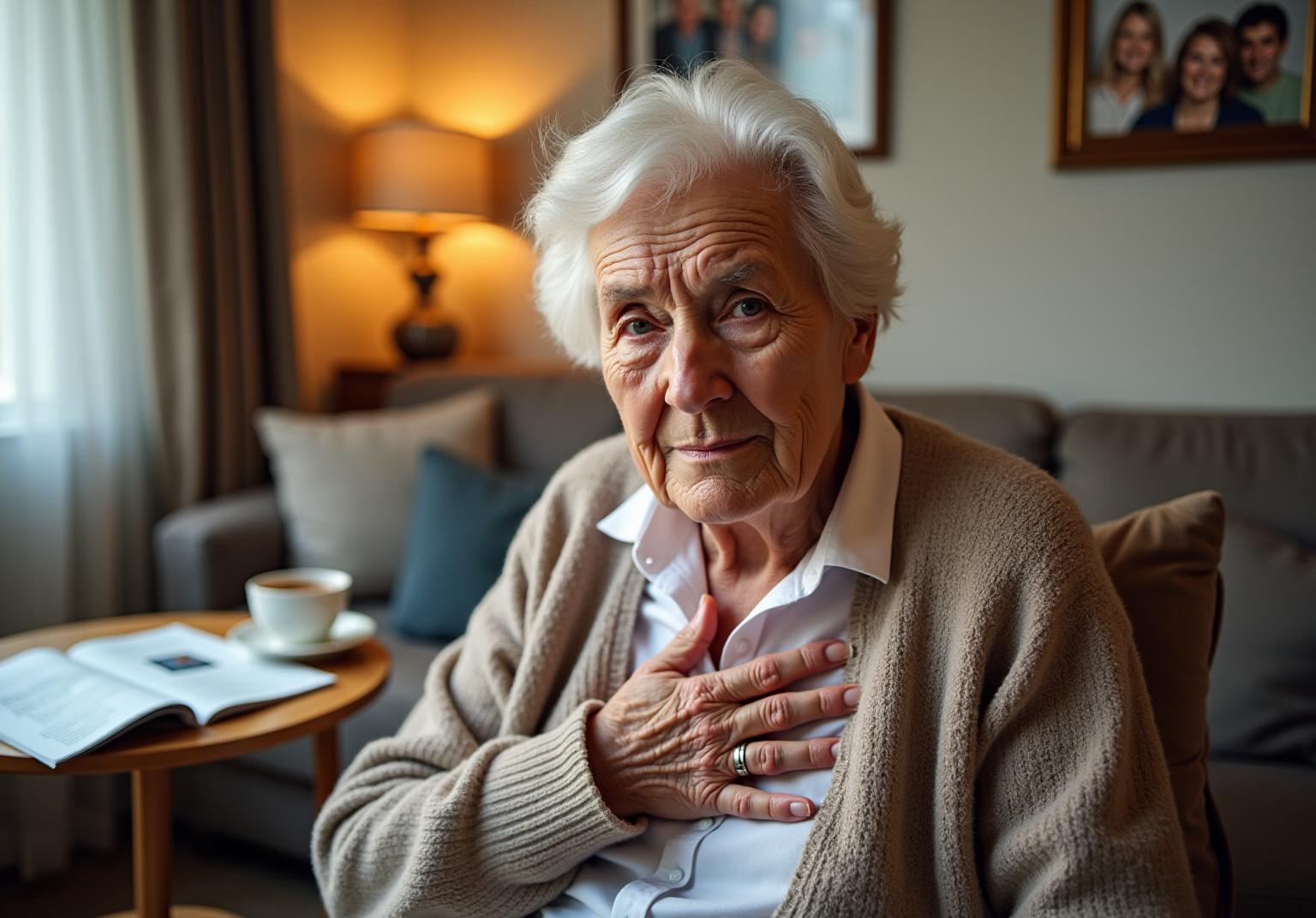


This article highlights the essential symptoms of coronary heart disease that elderly patients should be aware of to ensure they receive timely medical intervention. Recognizing symptoms such as chest pain, shortness of breath, fatigue, and nausea is crucial, as these can often present subtly in older adults. This subtlety may lead to delays in treatment, which can have serious health consequences.
In addition to this, it’s important to understand that being aware of these symptoms can empower patients. By acknowledging their concerns and recognizing the signs, they can take proactive steps towards their health. If you or someone you know experiences these symptoms, please don’t hesitate to reach out for help. Remember, timely action can make a significant difference in health outcomes.
Furthermore, this awareness is not just about identifying symptoms; it’s about fostering a supportive environment where elderly patients feel valued and cared for. Each symptom may evoke different emotions, and it’s perfectly normal to feel anxious or uncertain. You are not alone in this journey, and there are resources available to guide you.
Ultimately, understanding these symptoms and their implications can lead to better health management. By staying informed and seeking help when needed, elderly patients can navigate their health with confidence and reassurance. Your health matters, and recognizing these signs is a vital step towards a healthier future.
Recognizing the subtle signs of coronary heart disease is vital, especially for the elderly, whose symptoms often diverge from traditional expectations. Understanding these indicators can lead to timely interventions that significantly improve health outcomes. But what happens when these signs—like chest pain, shortness of breath, or even fatigue—are overlooked or misinterpreted? This article delves into the ten key symptoms of coronary heart disease that every elderly patient should be aware of.
By empowering them to take control of their cardiovascular health, we hope to encourage them to seek the necessary care. Your health is important, and understanding these signs can be the first step towards a healthier future.
At Amavita Heart and Vascular Health, we understand the importance of recognizing early signs of coronary heart disease symptoms, especially for our senior community. Often, being aware of coronary heart disease symptoms is crucial, as they can be subtle or not what one might expect, making timely intervention important. Did you know that research indicates early identification significantly improves outcomes? Our cardiologists advocate for recognizing coronary heart disease symptoms sooner, ensuring that you receive the care you need when it matters most.
Routine examinations and client education are key components of this proactive approach. We believe in empowering seniors and their families to actively . By fostering awareness of CAD indicators, we aim to enhance the quality of life for those we care for. Remember, you are not alone in this journey; we are here to support you every step of the way. Together, we can ensure that you receive the assistance you require, providing peace of mind and a healthier future.

Chest pain, often referred to as angina, serves as a crucial warning sign of coronary heart disease symptoms. This discomfort may present as pressure, squeezing, or a feeling of fullness in the chest. However, for elderly patients, these signs can often be subtle or misinterpreted as other health issues, such as indigestion or musculoskeletal pain. This misinterpretation can lead to , increasing the risk of serious complications like cardiac arrests.
Research shows that atypical presentations of chest pain are common among older adults, making it vital for caregivers and family members to remain vigilant. Cardiologists emphasize the importance of recognizing coronary heart disease symptoms, including angina indicators, in this demographic to ensure timely intervention. For instance, a study involving older individuals revealed that exertional chest pain is a strong predictor of coronary heart disease symptoms and mortality, highlighting the urgent need for awareness and prompt assessment.
As we look ahead to 2025, news reports continue to underline the importance of understanding coronary heart disease symptoms and chest pain in seniors. Many may hesitate to seek emergency care due to worries about costs or feelings of embarrassment. However, timely evaluation is essential; delaying treatment can cause irreversible damage to the heart tissue. Therefore, it is crucial for both individuals receiving care and their support networks to prioritize cardiovascular health and respond promptly when experiencing any form of chest discomfort. Remember, you are not alone in this journey, and seeking help is a vital step towards maintaining your health.
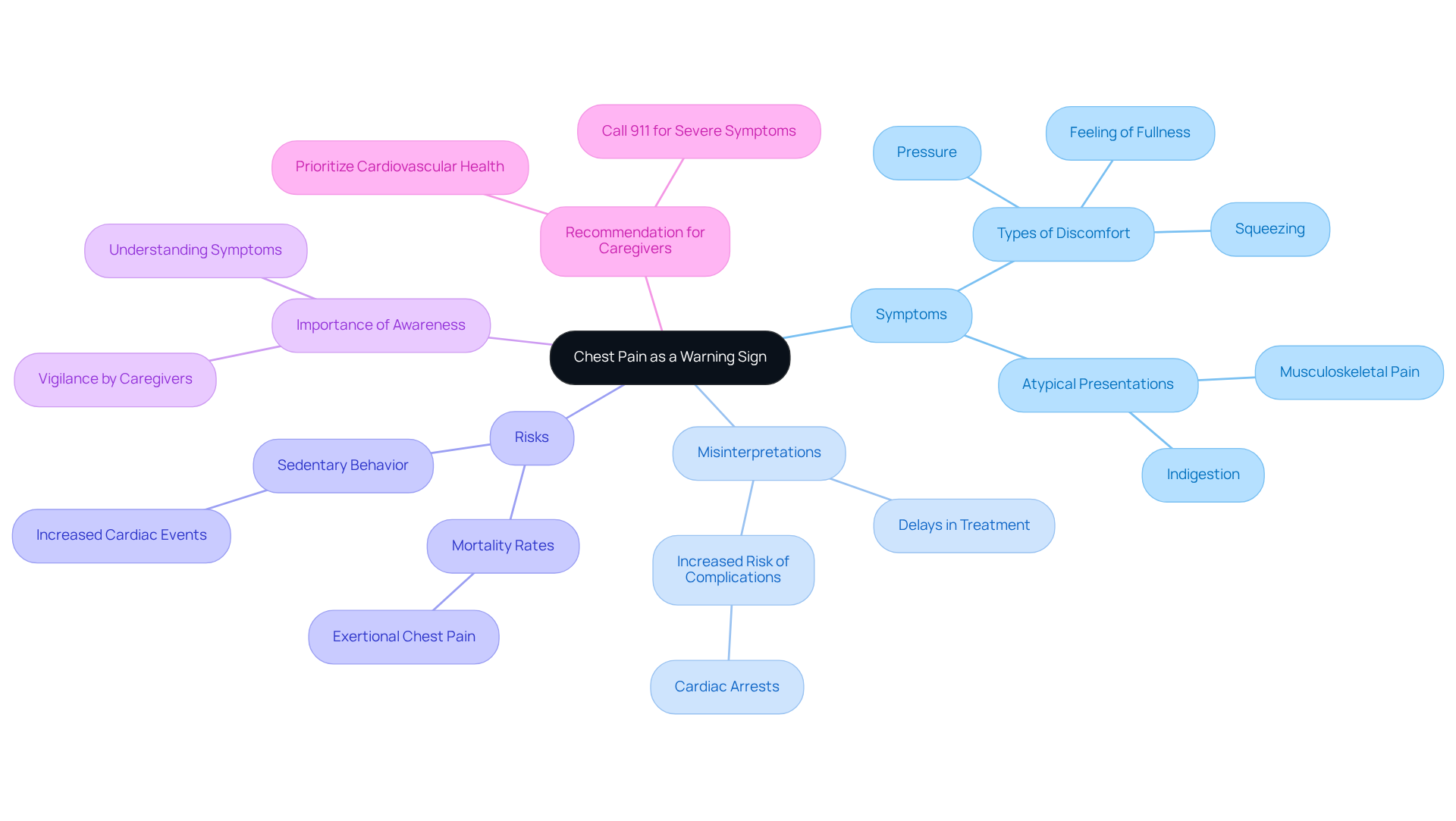
Shortness of breath, or dyspnea, is an important warning sign of potential cardiovascular issues, particularly coronary heart disease symptoms, especially for our elderly loved ones. This symptom can arise during physical activity or even at rest, which may be a sign of coronary heart disease symptoms, indicating that the heart may struggle to pump blood effectively. It's concerning to note that individuals who experience dyspnea, which can be one of the coronary heart disease symptoms, are 2 to 9 times more likely to face serious health outcomes related to heart and lung diseases compared to those without this symptom.
For older adults, dealing with dyspnea, often associated with coronary heart disease symptoms, can be particularly distressing and frequently leads to feelings of anxiety. The prevalence of coronary heart disease symptoms in this age group is alarming, as studies indicate a strong correlation with increased mortality rates. For instance, a recent study highlighted that over half of the patients admitted to hospitals with breathlessness passed away within a year, emphasizing the critical need for integrated care and support.
Healthcare professionals stress the importance of recognizing dyspnea as a serious red flag. As one specialist wisely noted, "Tackling the root causes of dyspnea is crucial for enhancing outcomes and quality of life." Real-life experiences illustrate this point: many elderly individuals report episodes of breathlessness that lead to emergency visits, often revealing coronary heart disease symptoms and underlying cardiovascular issues that require immediate attention.
As we move into 2025, the conversation surrounding dyspnea in older individuals has gained significant traction, particularly in light of rising mortality rates. Public health initiatives are increasingly dedicated to educating communities about the importance of early diagnosis and intervention. Understanding the context and causes of shortness of breath, particularly coronary heart disease symptoms, is vital for timely medical intervention, which can lead to better management of cardiovascular health and an improved quality of life for older individuals.
If you or a loved one is experiencing these symptoms, please reach out for support. You are not alone, and there are with care and compassion.
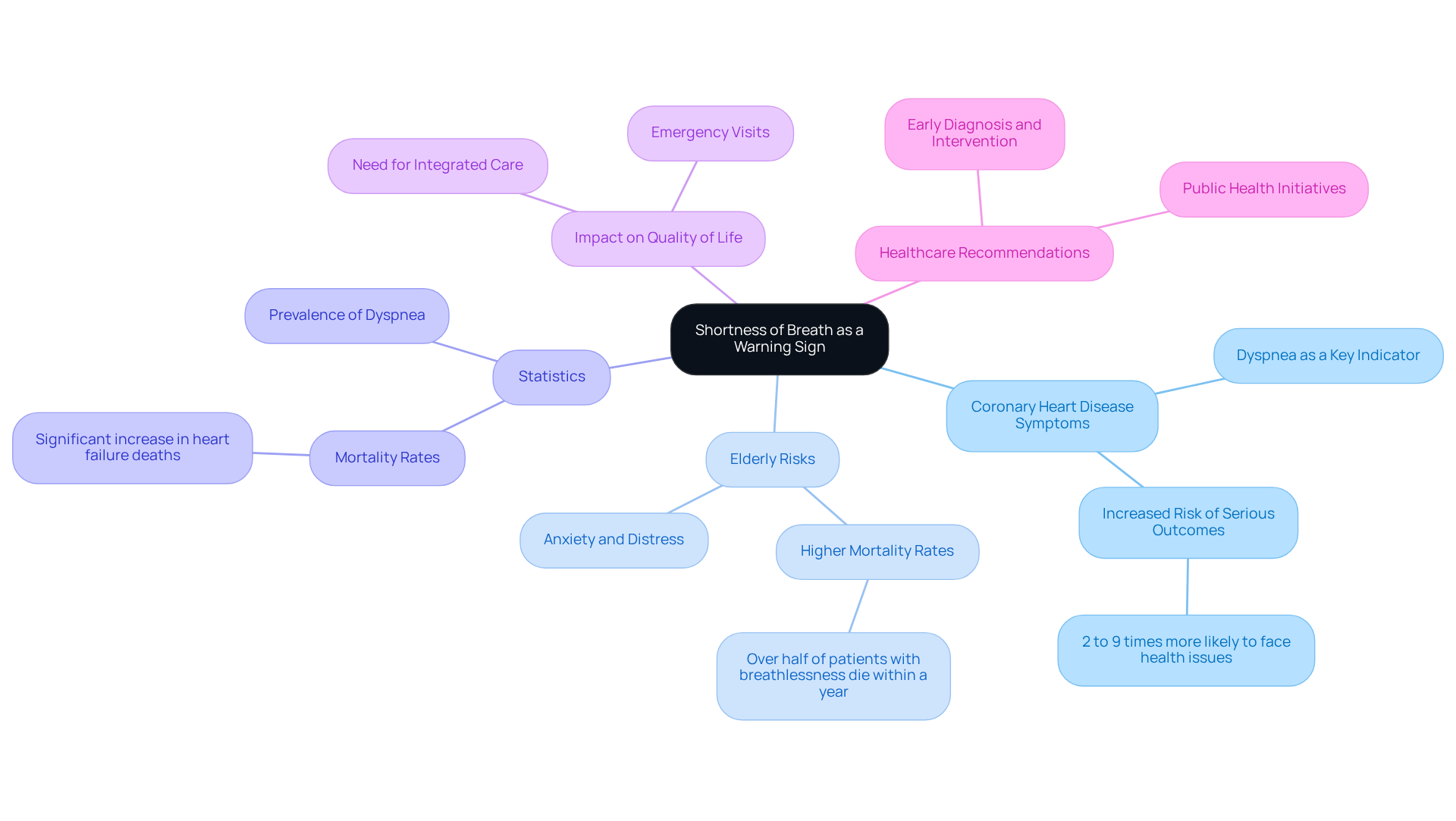
Fatigue is often overlooked as one of the coronary heart disease symptoms, especially among older patients. This symptom may manifest as a persistent sense of tiredness or reduced energy, frequently misattributed to the natural aging process. However, ongoing fatigue might suggest that the heart is not functioning at its best. Cardiologists emphasize the importance of recognizing fatigue as a potential indicator of coronary heart disease symptoms, urging patients to discuss any new or worsening fatigue with their healthcare provider for further evaluation.
At Amavita Cardiovascular Health, we understand that fatigue can stem from various cardiac conditions, including coronary heart disease symptoms and heart failure. Our comprehensive cardiac assessments are designed to identify the specific causes of fatigue, allowing us to create personalized treatment plans focused on improving cardiovascular health and restoring energy levels. Research shows that fatigue is a prevalent concern among older adults, with studies indicating that a notable percentage of seniors report fatigue as a precursor to cardiovascular events. For example, a recent study found that individuals experiencing significant fatigue had a 2.17 times higher risk of facing cardiovascular events compared to those who were less fatigued. This connection highlights the , particularly in those with existing cardiovascular problems, such as coronary heart disease symptoms.
Distinguishing between normal aging and heart-related fatigue can be difficult. While some fatigue is a natural part of getting older, sudden or severe fatigue that interferes with daily activities should be taken seriously. Real-life examples illustrate this: elderly patients who once led active lives may suddenly feel unusually fatigued after minimal exertion, like climbing a few stairs. Such changes can serve as crucial warning signs of potential cardiac concerns.
Given these insights, it is vital for healthcare professionals to educate older adults about the possible implications of fatigue on cardiovascular health. By fostering open conversations about exhaustion and its potential links to coronary heart disease symptoms, individuals can take proactive steps toward enhancing their cardiovascular health and overall well-being. Moreover, at Amavita, we are dedicated to raising awareness about the impact of fatigue on cardiovascular wellness, ensuring that older patients receive the necessary evaluations and treatments. Our preventive cardiology approach combines advanced assessment tools with personalized interventions, addressing contributing factors such as family history, high blood pressure, and diabetes to significantly lower the risk of a cardiac event.

Palpitations, which are sensations of irregular heartbeats, can be quite alarming for many individuals, particularly seniors. These sensations might feel like a racing heart, fluttering, or skipped beats. While palpitations can sometimes be harmless, they may also indicate or other cardiovascular issues, especially in older adults. Research indicates that the likelihood of arrhythmias increases significantly starting at age 50, with each additional year raising the chance of atrial arrhythmias by 9% and ventricular arrhythmias by 4%. Given this heightened risk, it is essential for patients experiencing frequent or severe palpitations to seek medical advice promptly.
At Amavita Heart and Vascular Health, our specialists are dedicated to providing compassionate care. We utilize advanced diagnostic imaging, including portable, FDA-cleared AI ultrasound technology, to accurately evaluate cardiac conditions. This innovative method allows for real-time guidance and swift reporting on cardiac structure and function, facilitating early detection and informed decision-making. Furthermore, we offer minimally invasive procedures to manage arrhythmias effectively, ensuring that patients receive comprehensive care tailored to their individual needs.
Real-life experiences shed light on the implications of these irregular heartbeats. Many seniors share stories of palpitations leading to further investigations, uncovering conditions such as atrial fibrillation or supraventricular tachycardia. Cardiologists emphasize that these signs should not be overlooked, as they can serve as early indicators of potential cardiac issues. Dr. Amit Moses, a lead researcher in cardiovascular studies, underscores the importance of early detection, stating, "These findings are a powerful reminder that the organ often whispers before it shouts." This highlights the need for vigilance regarding subtle signs like frequent irregular heartbeats, which can signal future risks before more severe symptoms arise.
In light of recent findings, it is evident that understanding palpitations is crucial for older adults. The study suggests that screening for arrhythmias should ideally begin around age 50 to enable timely intervention and improve long-term outcomes. As the prevalence of conditions like atrial fibrillation continues to rise—estimated to affect over 10.5 million adults in the U.S.—the need for awareness and proactive health management becomes increasingly vital. If you experience palpitations, we encourage you to consult your healthcare provider for evaluation and potential screening. At Amavita, we are committed to providing thorough arrhythmia management and patient-focused care to enhance your cardiovascular well-being.

Dizziness can serve as an important warning sign of coronary artery disease, often presenting as lightheadedness or a feeling of faintness. For older adults, this symptom may arise from various factors, including medication side effects or dehydration. It's essential to understand that cardiovascular issues might also be involved, as dizziness can indicate insufficient blood flow to the brain. For instance, persistent dizziness may be linked to abnormal circulatory rhythms or valve conditions, which require prompt medical attention.
Statistics indicate that dizziness, along with coronary heart disease symptoms like shortness of breath and chest discomfort, frequently (CAD). If you or a loved one is experiencing frequent dizziness, it’s crucial to consult a healthcare provider for a thorough assessment. Early identification and making lifestyle changes can significantly lower the risks associated with cardiovascular disease. Remember, you’re not alone in this, and there are steps you can take to improve your health and well-being.

Swelling in the legs or feet, often referred to as edema, is a common symptom associated with heart failure, particularly among older adults. This condition arises when the heart struggles to pump blood effectively, leading to fluid buildup in the lower extremities. Did you know that approximately 19% to 20% of older adults in the U.S. experience chronic peripheral edema? This issue is especially prevalent in those with cardiovascular concerns. Many older individuals notice this swelling after prolonged periods of sitting or standing, highlighting the importance of recognizing this sign early.
Cardiologists stress that timely identification of edema can pave the way for prompt medical evaluation and effective management of heart failure, ultimately enhancing patient outcomes. Real-life experiences reveal that those with peripheral edema often face mobility challenges and increased discomfort, complicating their overall health. Conditions such as Peripheral Artery Disease (PAD) and Chronic Venous Insufficiency (CVI) can exacerbate these problems, leading to further complications if left unaddressed.
At Amavita Heart and Vascular Health, our compassionate specialists utilize advanced diagnostic imaging, including the Amavita CardioElite™ program, to uncover underlying issues. We offer minimally invasive treatments, such as venous ablation and sclerotherapy, designed to . Recognizing this sign is crucial for seniors and their caregivers, as it can serve as an important indicator of underlying coronary heart disease symptoms.
It's also vital to acknowledge that chronic peripheral edema disproportionately impacts women, racial minorities, and individuals with lower socioeconomic status. This highlights the need for targeted awareness and intervention strategies. We encourage you to reach out for support and guidance, as understanding and addressing these concerns can significantly improve quality of life.
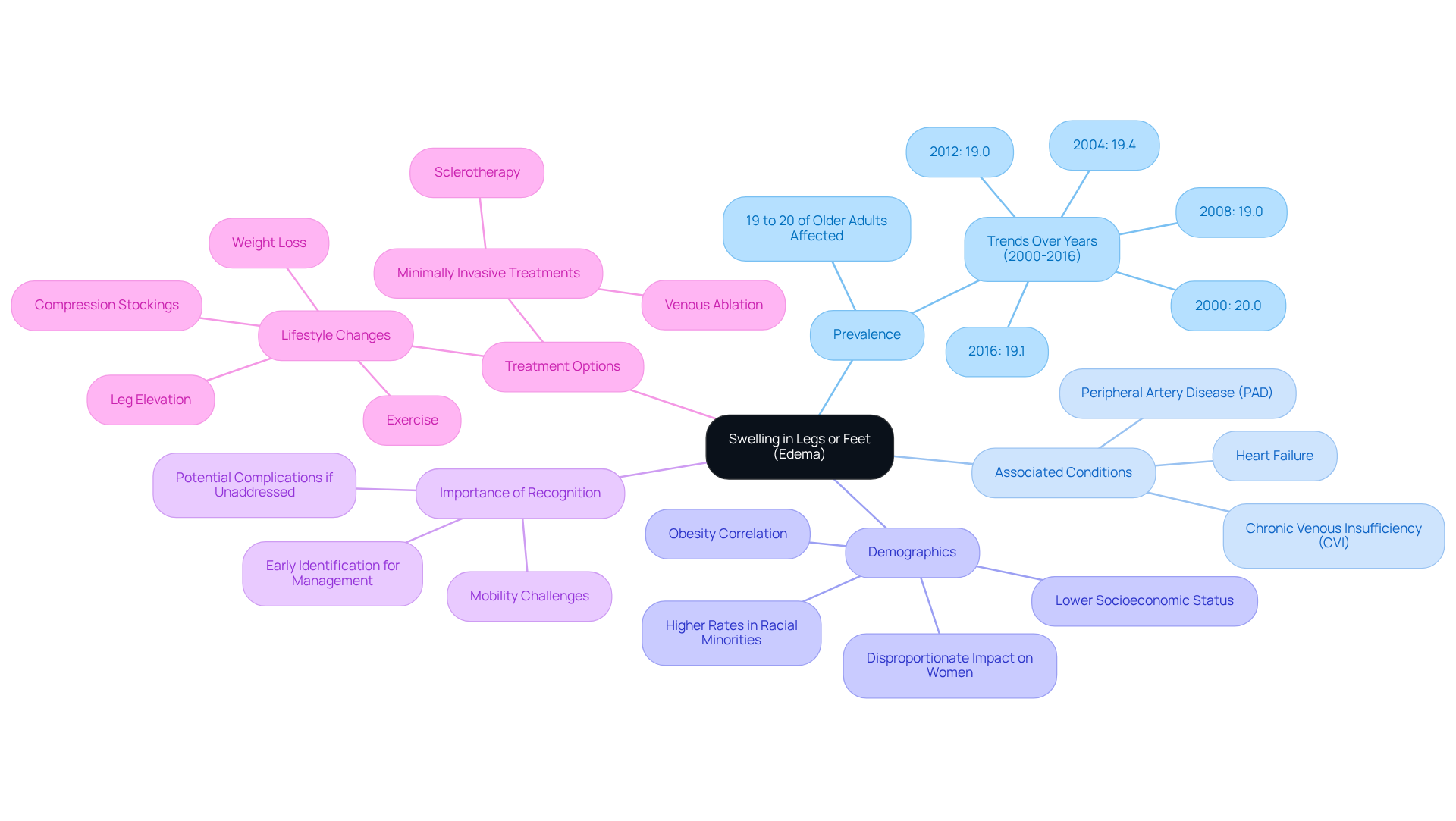
Nausea is often overlooked as a warning sign of coronary heart disease symptoms, especially among older individuals who might dismiss it as unrelated to their heart health. However, this feeling can indicate reduced blood flow to the gastrointestinal tract or other cardiac issues. Studies reveal that older adults frequently display atypical coronary heart disease symptoms, such as nausea, which can delay diagnosis and treatment. For example, a 75-year-old man with a history of heart problems experienced nausea and vomiting, ultimately uncovering a serious underlying condition.
Healthcare professionals emphasize the importance of recognizing these subtle signs that may indicate coronary heart disease symptoms. Dr. Jessica Sutherland, an interventional cardiologist, emphasizes that even if patients do not experience the classic chest-clutching pain, they should not hesitate to seek medical help for any coronary heart disease symptoms if something feels off. This sentiment is echoed by research showing that many women, in particular, experience unusual coronary heart disease symptoms such as nausea, which can impede timely interventions. Heart disease accounts for about 1 in every 5 female deaths, highlighting the urgent need for women to be aware of coronary heart disease symptoms, such as nausea.
At Amavita Heart and Vascular Health®, we understand the importance of recognizing these signs and offer comprehensive cardiac assessments tailored for individuals at high risk. Our preventive cardiology approach combines advanced risk assessment tools, such as echocardiograms and stress tests, with personalized interventions. This ensures that patients experiencing unexplained nausea—especially when accompanied by other coronary heart disease symptoms like fatigue or shortness of breath—receive the necessary evaluations and care. As discussions surrounding cardiovascular wellness continue into 2025, recognizing nausea as a potential indicator of coronary heart disease symptoms remains critical. With over 60 million women in the U.S. living with some form of cardiovascular condition, can significantly improve early detection and treatment outcomes. We encourage patients to consult their healthcare provider to rule out serious conditions.
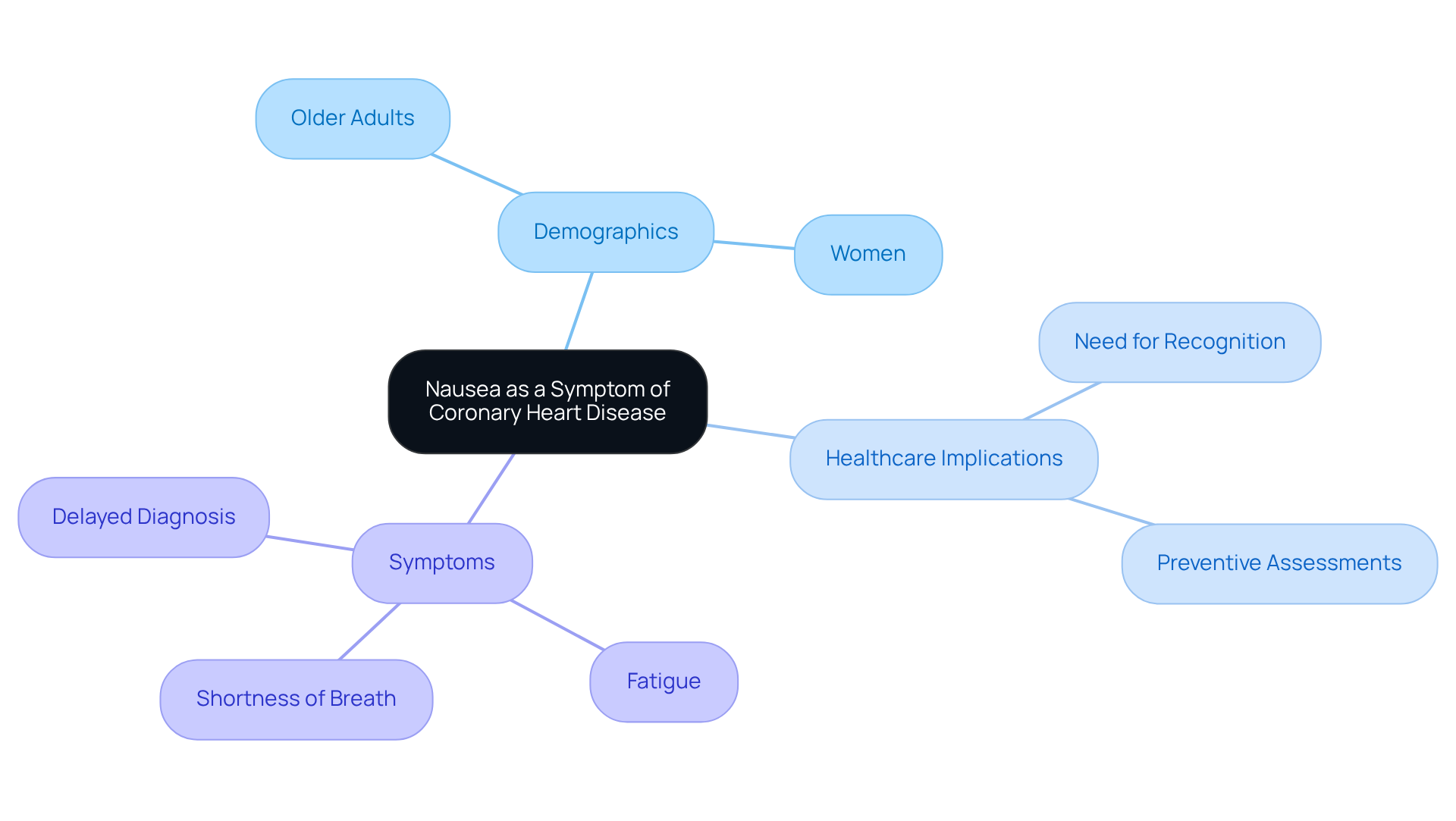
Cold sweats can be a vital signal of heart problems, particularly during a heart attack. This symptom, often regarded as one of the coronary heart disease symptoms, can appear unexpectedly and may come with other warning signs, such as chest pain or shortness of breath. For our elderly loved ones, recognizing cold sweats is crucial, as they can indicate a serious cardiac event that requires immediate medical attention. Studies indicate that cold sweats, especially when they occur without physical activity, may suggest that the heart is struggling to pump blood effectively. Many elderly individuals have shared their experiences of cold sweats alongside other signs during cardiac events, underscoring the need for heightened awareness.
Cardiologists remind us that any sudden onset of cold sweats, especially when paired with discomfort in the chest or unusual fatigue, could be indicative of coronary heart disease symptoms that require urgent evaluation. At Amavita Cardiovascular Health®, we emphasize the importance of preventive strategies, including lifestyle changes and risk assessment tools, to help reduce the chances of cardiac events. Understanding this indication can significantly improve outcomes, as is essential for managing heart health. If you or someone dear to you experiences these signs, we encourage you to seek assessment promptly. Remember, you are not alone in this journey, and we are here to support you every step of the way.
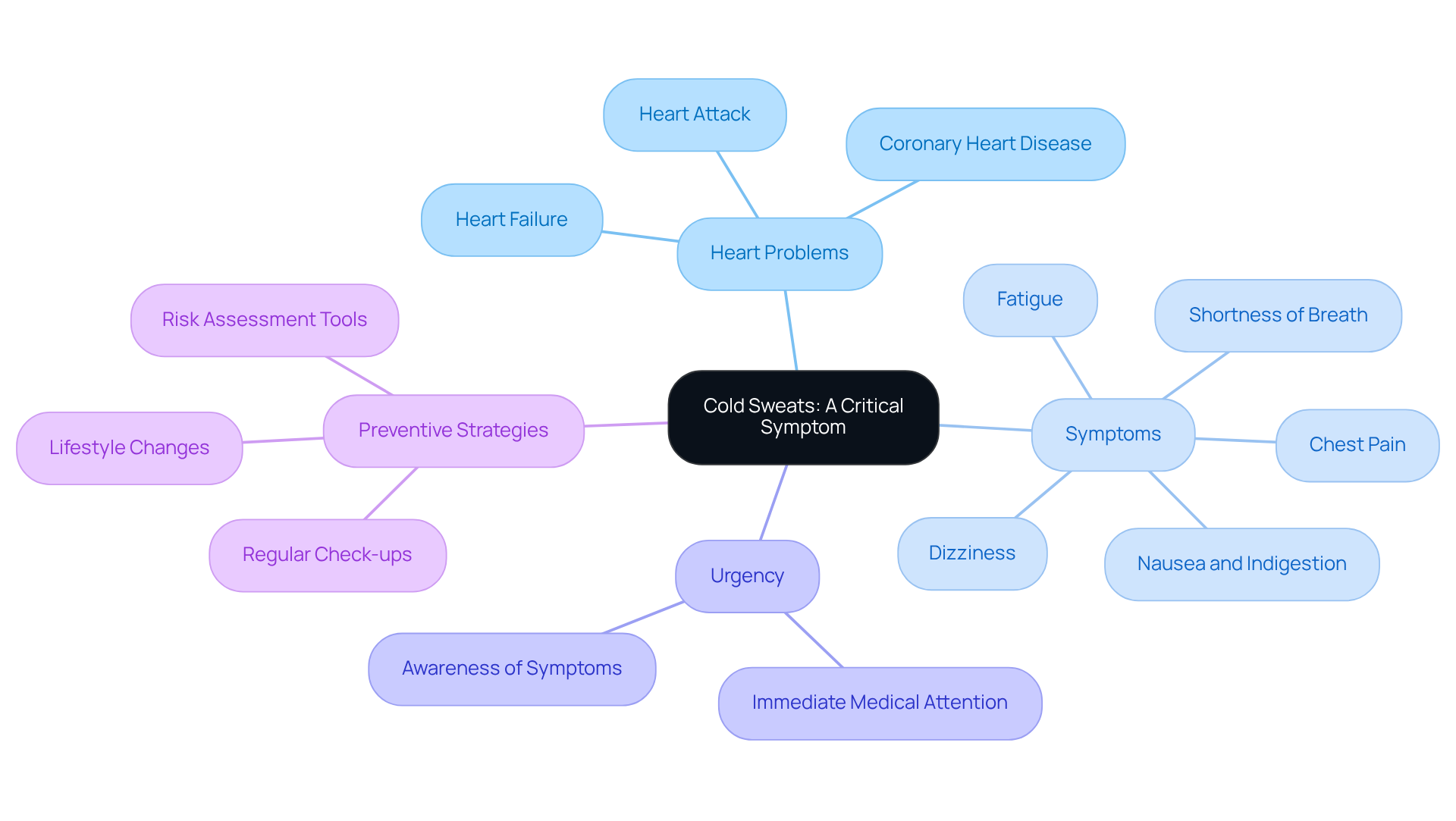
Senior patients, it’s important to seek prompt medical care if you experience any combination of concerning signs, such as coronary heart disease symptoms including chest pain, shortness of breath, dizziness, or cold sweats. Recognizing the urgency of coronary heart disease symptoms is crucial, as they can indicate serious heart conditions that need immediate attention. Research shows that timely consultations with healthcare providers can significantly enhance health outcomes for seniors facing these symptoms. For example, studies indicate that patients who act quickly when experiencing chest pain or shortness of breath often receive more effective treatment, leading to better recovery rates.
At Amavita Heart and Vascular Health®, we are dedicated to your well-being. Our thorough cardiac assessments are designed to detect potential issues early, allowing for tailored interventions that can greatly reduce the likelihood of a heart attack. Our preventive cardiology approach combines advanced evaluation tools with customized strategies to meet your individual needs. Healthcare experts emphasize that recognizing and responding to coronary heart disease symptoms can be life-saving, particularly for elderly individuals who are at an increased risk for cardiovascular problems.
Dr. Neha J. Pagidipati reminds us, "Uncontrolled high blood pressure is likely the biggest contributor to cardiovascular disease that people can change," highlighting the importance of proactive measures. Our innovative AI-powered diagnostic technology, including the CardioElite™ program, enhances early detection, ensuring that you receive accurate assessments and timely care.
Therefore, it is crucial for seniors and their caregivers to prioritize when these signs occur. Keeping a list of specific symptoms, such as:
to discuss with your healthcare provider can also facilitate timely and effective care. Remember, you are not alone in this journey; support is available, and taking the first step can make all the difference.

Recognizing the symptoms of coronary heart disease is essential for elderly patients, as early intervention can significantly improve health outcomes. This article highlights the importance of awareness surrounding key indicators such as:
Each symptom serves as a critical warning sign that demands attention, underscoring the necessity for seniors and their caregivers to remain vigilant about their cardiovascular health.
Throughout the discussion, the article emphasizes the subtlety of many coronary heart disease symptoms in older adults and the common misinterpretations that can occur. For instance, chest pain may be dismissed as indigestion, while fatigue is often attributed to aging. These insights remind us that timely recognition and response to these symptoms are vital for preventing serious complications. Seeking immediate medical attention can lead to prompt diagnosis, effective treatment, and ultimately, a better quality of life.
The significance of this awareness cannot be overstated. As the prevalence of coronary heart disease continues to rise among the elderly population, proactive measures such as:
are crucial. Empowering seniors to recognize and act upon these warning signs can lead to improved health outcomes and a healthier future. It is essential to foster an environment where concerns about heart health are taken seriously, ensuring that no one navigates this journey alone. Remember, you are not alone in this; support is always available.
What is the importance of recognizing early signs of coronary artery disease?
Recognizing early signs of coronary artery disease is crucial as symptoms can be subtle or unexpected. Early identification significantly improves outcomes, allowing for timely intervention and care.
What are the key components of Amavita Heart and Vascular Health’s approach to coronary artery disease?
Amavita Heart and Vascular Health emphasizes routine examinations and client education, empowering seniors and their families to monitor cardiovascular health actively and recognize indicators of coronary artery disease.
What is chest pain, and why is it significant in relation to coronary heart disease?
Chest pain, or angina, is a crucial warning sign of coronary heart disease. It may present as pressure, squeezing, or fullness in the chest, and can often be misinterpreted by elderly patients, leading to delays in treatment.
How can chest pain present differently in elderly patients?
In elderly patients, chest pain may be subtle or mistaken for other issues like indigestion or musculoskeletal pain, increasing the risk of serious complications if not recognized promptly.
What does research indicate about atypical presentations of chest pain in older adults?
Research shows that atypical presentations of chest pain are common among older adults, making it essential for caregivers and family members to remain vigilant and recognize these symptoms for timely intervention.
What is shortness of breath and its significance in heart health?
Shortness of breath, or dyspnea, is a significant warning sign of potential cardiovascular issues, particularly coronary heart disease. It can occur during physical activity or at rest and may indicate the heart's inability to pump blood effectively.
What are the risks associated with dyspnea in older adults?
Individuals experiencing dyspnea are 2 to 9 times more likely to face serious health outcomes related to heart and lung diseases compared to those without this symptom, highlighting the need for prompt medical evaluation.
How does dyspnea impact the quality of life for elderly individuals?
Dyspnea can lead to anxiety and distress among elderly individuals. Studies indicate a strong correlation between dyspnea and increased mortality rates, underscoring the importance of integrated care and support.
What should individuals experiencing symptoms of coronary heart disease do?
If you or a loved one is experiencing symptoms like chest pain or shortness of breath, it is crucial to seek medical support promptly. There are resources available to help navigate these challenges.